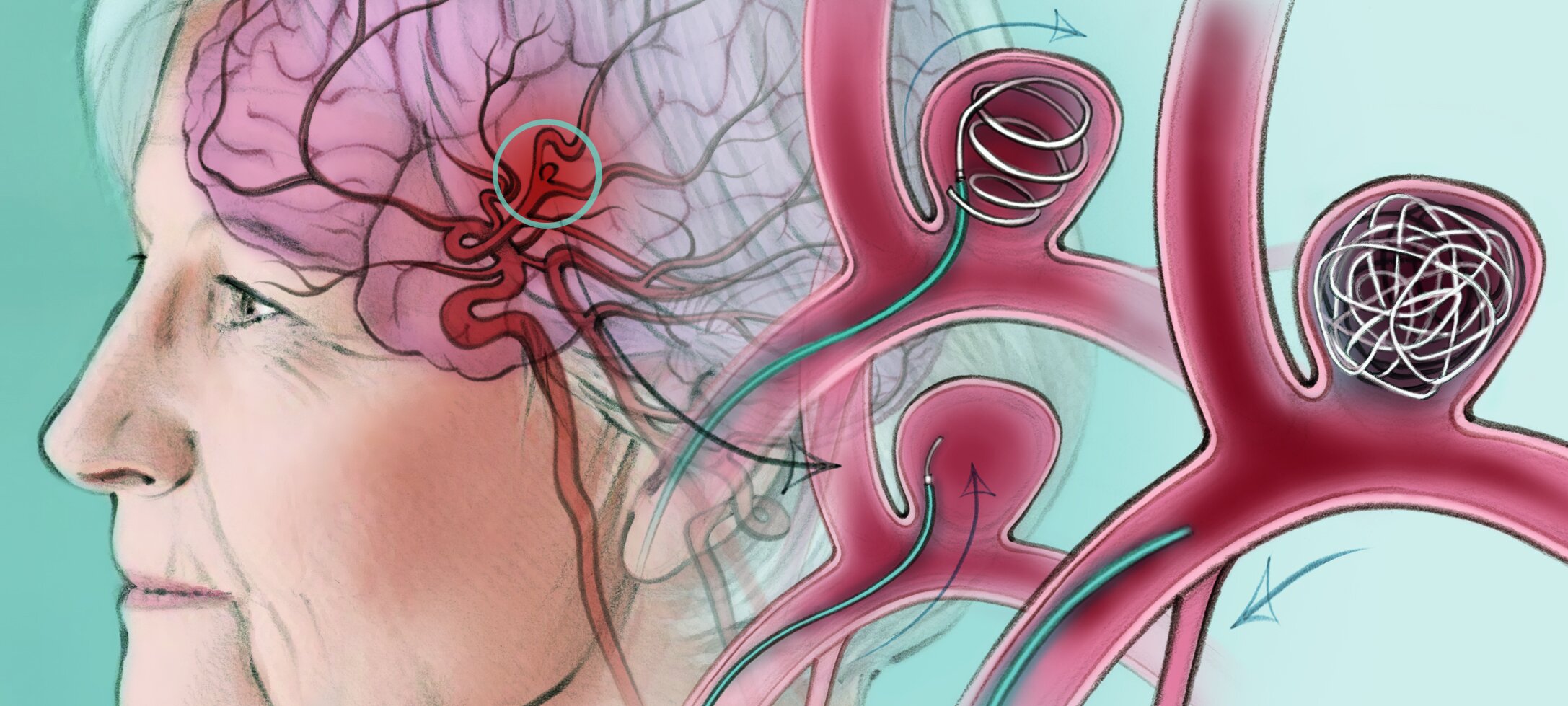What is a brain aneurysm?
A brain aneurysm is a weakened artery in the brain that stretches out like a balloon. It can burst or bleed in the brain. When this occurs, it can lead to death or disability. Every year, about 30,000 people in the US have brain aneurysms that burst.
What is a MIIP for a brain aneurysm?
A MIIP is a minimally invasive, image-guided procedure. A MIIP for brain aneurysms keeps them from filling with blood so they cannot bleed. The clinician numbs the skin on the upper thigh or wrist. They thread a small plastic tube through the skin into an artery. They use moving x-rays to guide the tube to the aneurysm in the brain. They may fill the aneurysm with soft metal coils or special glue. They may also put a mesh metal tube called a stent across the aneurysm to let blood flow past it. The aneurysm is blocked off and cannot fill with blood. They hold pressure for 15-20 minutes or close the hole in the artery with a small device. They put a bandage over the pinhole in the skin.
MIIP for Brain Aneurysms
1. After numbing the skin, the clinician threads a small tube through the artery and to the aneurysm in the brain.
2. They block off the aneurysm by filling it with soft metal coils or special glue.
3. Once the blocked off aneurysm cannot fill with blood, the clinician removes the tube and places a bandage over the pinhole in the skin.
What are the risks?
In 5 in 100 people, the aneurysm will burst while trying to treat it, causing a stroke or bleeding in the brain. Newer tools available now may reduce this risk.
Less than 2 in 100 people develop an infection, have bleeding, or experience damage to the artery where the tube entered the body
What are the alternatives?
Your treatment options depend on your preferences and your unique conditions. These include your type of aneurysm, whether it has burst, and your other health conditions.
Alternative 1 No treatment. Some small aneurysms do not need treatment and can be watched over time with imaging tests.
Alternative 2 Surgical clipping. Surgery can be performed to place a small clip on the aneurysm to block it off called “clipping.” The surgery has a higher risk of complications but a higher success rate overall.
Frequently asked questions
How do I know if I have a brain aneurysm?
Usually a small brain aneurysm does not cause any symptoms. Big aneurysms can press on nerves to cause symptoms like these:
blurry vision
headache
pain behind eye
a droopy eyelid
A medical imaging test like a CT or MRI can find out whether your symptoms are caused by a brain aneurysm.
What are the symptoms of a bleeding or burst brain aneurysm?
A bleeding brain aneurysm is a medical emergency! Symptoms of a bleeding or burst brain aneurysm are
Severe headache, often described as “the worst headache of my life”
Stiff neck
Sudden blurred vision
Sensitivity to light
Dizziness
Changed level of awareness or consciousness
Seizure
Stroke-like symptoms
Every year, about 30,000 people in the US have ruptured brain aneurysms. About 40% of them die from the aneurysm - sadly, 10% will die before they can even get treatment. It is difficult to know why or when an aneurysm will burst, but factors that can increase the chances that an aneurysm will bursting are
High blood pressure
Straining or strong emotions that increase blood pressure quickly
Blood thinners
Cocaine or other stimulants
What are the risks of treatments for a brain aneurysm?
Your doctor will discuss all of the risks and benefits of treatment for your brain aneurysm, depending on its size, location, and whether or not it has burst. Both MIIPs and surgery carry a risk of damaging the brain, though the risks are smaller with the MIIP. However, the chance of bleeding again in the future is higher with the MIIP. Knowing your options and discussing them with your medical team will help you decide on the best treatment for you.
For more information about brain aneurysm:




